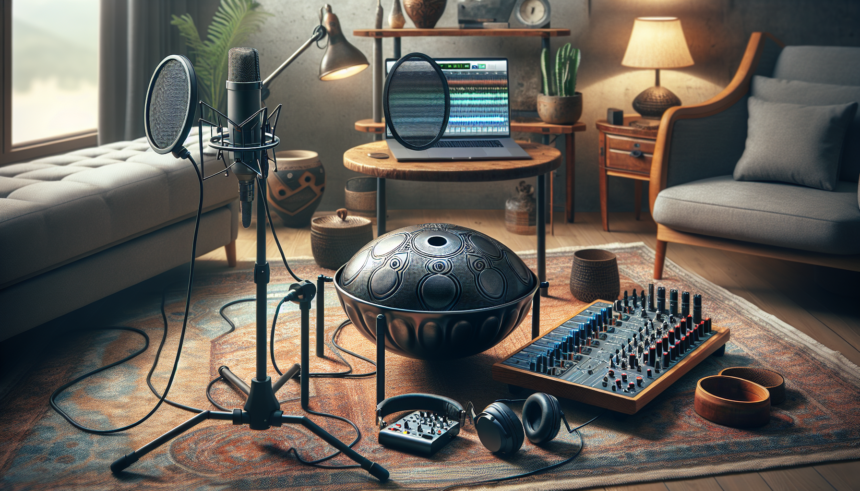<!DOCTYPE html>
<html lang="en">
<head>
<meta charset="UTF-8">
<meta name="viewport" content="width=device-width, initial-scale=1.0">
<title>Essential Gear for Recording Handpan Music at Home</title>
<style>
body {
font-family: Arial, sans-serif;
line-height: 1.6;
margin: 20px;
padding: 0;
color: #333;
}
h1, h2, h3 {
color: #444;
}
p {
margin-bottom: 15px;
}
ul {
margin-bottom: 20px;
}
</style>
</head>
<body>
<h1>Essential Gear for Recording Handpan Music at Home</h1>
<p>
Recording music at home has never been more accessible thanks to advancements in technology. Among various musical instruments, the handpan offers a unique auditory experience characterized by its metallic resonance and harmonic overtones. For handpan enthusiasts looking to record their music at home, understanding the requisite gear is crucial to capturing the instrument's distinct sound. This article delves into the essential equipment required to record handpan music at its finest.
</p>
<h2>1. Microphones</h2>
<p>
The choice of microphone is fundamental when recording a handpan. Having a microphone that can capture the full range of the handpan's tonal complexities is crucial. Here are a few types that are often recommended:
</p>
<ul>
<li><strong>Condenser Microphones:</strong> These are popular for their sensitivity and ability to capture detailed audio, making them ideal for handpan recordings. They require an external power source (phantom power) provided by a preamp or audio interface.</li>
<li><strong>Dynamic Microphones:</strong> While not as sensitive as condenser microphones, dynamic microphones can handle high sound pressure levels and are more robust in various recording environments. They can be suitable if you want a different tone or are recording in a noisy setting.</li>
<li><strong>Stereo Microphone Pairing:</strong> Utilizing a pair of microphones can create a stereo image that captures the spatial aspects of playing the handpan, enhancing the listening experience.</li>
</ul>
<h2>2. Audio Interface</h2>
<p>
An audio interface is an essential component that connects your microphones to your computer. It converts analog audio signals into digital data that your computer can process. When choosing an audio interface, consider:
</p>
<ul>
<li><strong>Number of Inputs:</strong> Ensure the interface has enough inputs to accommodate your microphone setup, especially if employing a stereo setup.</li>
<li><strong>Preamp Quality:</strong> High-quality preamps are crucial, as they amplify microphone signals without introducing excess noise.</li>
<li><strong>Latency:</strong> Choose interfaces known for low latency to ensure a smooth recording experience.</li>
</ul>
<h2>3. DAW (Digital Audio Workstation)</h2>
<p>
A DAW is software used to record, edit, and produce audio files. It's a critical tool for refining your recordings. Some popular DAWs include:
</p>
<ul>
<li><strong>Logic Pro X:</strong> Known for its user-friendly interface and robust audio editing features. It is exclusive to Mac users.</li>
<li><strong>Ableton Live:</strong> Preferred for its live recording and easy looping features. It's suitable for both PC and Mac users.</li>
<li><strong>Pro Tools:</strong> Often considered the industry standard, Pro Tools offers extensive editing capabilities and professional-grade sound quality.</li>
</ul>
<h2>4. Room Acoustics and Soundproofing</h2>
<p>
The acoustics of your recording environment significantly impact the sound quality. Good acoustics can enhance the natural tones of the handpan, while poor acoustics can muddle recordings. Consider these elements:
</p>
<ul>
<li><strong>Acoustic Treatment:</strong> Use foam panels or fabric drapes to absorb sound reflections that can color recordings.</li>
<li><strong>Bass Traps:</strong> They help control low-frequency sounds that might resonate excessively.</li>
<li><strong>Soundproofing:</strong> Ensure that outside noise doesn’t interfere with your recordings by investing in proper soundproofing measures if necessary.</li>
</ul>
<h2>5. Headphones and Monitors</h2>
<p>
Accurate monitoring of your recordings is critical for producing clean, professional-sounding handpan music.
</p>
<ul>
<li><strong>Studio Headphones:</strong> Opt for open-back headphones for a more natural sound when mixing, as they provide a clear representation of what the final mix will sound like in an open space. Closed-back headphones are preferable during recording to prevent sound leakage.</li>
<li><strong>Studio Monitors:</strong> Invest in a good pair of studio monitors to hear the recordings in their true form, ensuring proper balance and frequency response.</li>
</ul>
<h2>6. Accessories and Cables</h2>
<p>
Don’t overlook the importance of quality accessories and cables, which connect all of your equipment and maintain sound integrity.
</p>
<ul>
<li><strong>XLR Cables:</strong> Use high-quality, balanced XLR cables to connect microphones to the audio interface.</li>
<li><strong>Pop Filters:</strong> Essential for recording vocals with minimal popping sounds from plosive consonants.</li>
<li><strong>Mic Stands and Shock Mounts:</strong> Ensure microphones are securely placed and free from handling noise using suitable stands and shock mounts.</li>
</ul>
<h2>7. Managing the Recording Process</h2>
<p>
Quality gear is only part of the equation. Managing the recording process efficiently can make a significant difference in achieving great sound.
</p>
<ul>
<li><strong>Preparation:</strong> Set up your gear in advance, ensuring connectivity and function, to focus fully on the creative process.</li>
<li><strong>Practice and Planning:</strong> Record practice runs to identify the best mic positions and playing techniques before capturing the final takes.</li>
<li><strong>Backup and Storage:</strong> Regularly back up your recordings, using both cloud services and physical storage options to prevent data loss.</li>
</ul>
<h2>Conclusion</h2>
<p>
Capturing the ethereal sounds of a handpan at home necessitates a thoughtful selection of equipment and an understanding of how each piece contributes to the final recording. By investing in quality microphones, a reliable audio interface, suitable DAW, proper room treatment, and accurate monitoring solutions, you can achieve pristine recordings that reflect the soulful depth of this unique instrument. Practice, patience, and attention to detail will ensure that each recording is a true representation of your artistic expression.
</p>
<h2>FAQs</h2>
<h3>1. What type of microphone is best for recording handpan music?</h3>
<p>
Condenser microphones are generally preferred for recording handpan music due to their sensitivity and ability to capture fine details. Employing a stereo setup with a pair of condenser microphones can help create a rich, immersive audio experience.
</p>
<h3>2. Do I need a special type of audio interface for handpan recording?</h3>
<p>
While you don't necessarily need a specialized audio interface for handpan recordings, choosing one with high-quality preamps and low latency is important. Make sure it has enough inputs to accommodate your microphone setup.
</p>
<h3>3. How important is soundproofing when recording handpan music?</h3>
<p>
Soundproofing is essential if you are recording in a noisy environment, as it prevents external noise from affecting the recording. However, good room acoustics and treatment can have a more significant impact on the sound quality of your recordings.
</p>
<h3>4. Can I use regular headphones for mixing handpan music?</h3>
<p>
While regular headphones can be used, they might not provide the most accurate sound representation. Studio headphones, particularly open-back ones, are recommended for mixing as they offer a more natural soundstage and better audio fidelity.
</p>
<h3>5. Is it necessary to use a DAW for recording handpan music?</h3>
<p>
Using a DAW is essential for recording, editing, and producing your music effectively. It offers tools to enhance your recordings, manage multiple tracks, and apply effects that can elevate the final sound quality.
</p>
</body>
</html>Essential Gear for Recording Handpan Music at Home

Leave a comment




